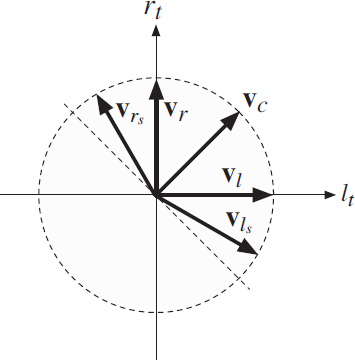2.4 Matrix surround
Matrix systems enabled wide spread use of surround sound. First in movie theaters as Dolby Stereo and later in homes as Dolby Surround [129]. One reason for the success of matrix systems is its stereo backward compatibility. Matrix systems ‘encode’ multiple audio channels into two stereo compatible audio channels. Given a matrix encoded stereo signal, a matrix decoder is applied to approximate the original multi-channel audio signal.
Early matrix systems were used to encode four audio channels into a stereo signal, denoted 4-2-4 systems [75]. Modern matrix systems, such as Dolby Prologic II [69], are capable of encoding 5.1 surround audio signals, if desired, including the LFE channel. More recently, also matrix systems for 6.1 and 7.1 signals have been introduced (e.g. Dolby Prologic IIx).

Figure 2.12 The vectors for encoding the five main channels of a 5.1 signal to two channels.
In the following, a simple 5-2-5 matrix system is described for encoding the various channels of a 5.1 surround audio signal. The audio channels are encoded as

where lf(t), rf(t), c(t), ls(t), rs(t) denote the front left, front right, front center, rear left, and rear right audio channels, respectively. The j denotes a 90° phase shift.
Alternatively, (2.3) can be written as
where the ...
Get Spatial Audio Processing: MPEG Surround and Other Applications now with the O’Reilly learning platform.
O’Reilly members experience books, live events, courses curated by job role, and more from O’Reilly and nearly 200 top publishers.

